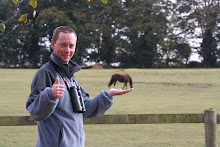
On my way back from checking a bittern report I was stopped by a lady who said that a Siberian chiffchaff had been singing on the Meadow Trail and a tour leader had heard it with a group. I walked around the dragonfly pool where there was a chiffchaff. The bird was not singing and didn't look grey as I would have expected for a sibe.
After lunch, Mark Golley came into the VC to say that he had just been up for the Iberian chiffchaff and although he hadn't heard it singing it looked very good for one. The lady had earlier mis-heard what had been said!! Got the gen from Mark and headed straight around the see the bird. With Mark's description the bird was quite easy to find in the same place. The bird was greener above than a normal chiff with cleaner white underparts and a buff wash to the flanks, the undertail was washed buff and it had a strong super but I still didn't hear it sing.
Checked the bird out after work but although it wasn't singing it was still present. Walked down to the fresh marsh with Rob where the drake garganey was sleeping on one of the islands. After about 10 mins, 3 terns came in over the fresh marsh and started to display which turned out to be Arctics. For the next 20 mins they circled over the lagoon display flighting and even landing on one the islands to display to each other. Eventually they were joined by a common tern and the 4 birds flew around together showing the differences between the species well.
On the way back I got a call from Dave to say that there was a bee-eater flying west over the carpark!! One of the locals had picked it up and phoned Dave at home. Rob and I scanned towards Thornham but it was still hawking over the trees and it looked like it was looking for somewhere to land as the rain had started again. We got back to the trees to see the bird showing well hawking over the tops. After 10 mins, the bird decided to leave and flew powerfully west towards Thornham, Dave arrived 2 mins late - doh!
Two Titchwell ticks (chiffchaff and bee-eater) takes my reserve list to 252 and the yearlist to 163 - what a top day.







